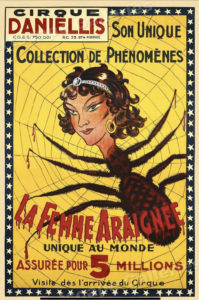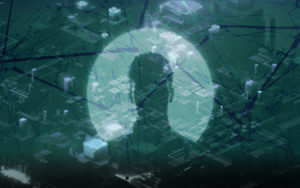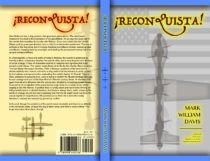¡Reconquista! is now available in paperback format with some additional editing (because there is rarely enough) and an alternative cover design. Pick it up now via reconquista.pub or direct from Amazon. I’m preparing for a book signing event in December with the Las Cruces Writers Group and need something a bit more tangible than an electronic book. But the movement towards NFTs and alternative distribution methods continues apace!… Read the rest
Author: Mark Davis
Bobos and Grifters
 It’s a good time to be a pundit trying to find a vein of gold that explains the polarization of modern America. Is it political, societal, sociological, psychological, economic, or some mixture of all of the above? Take David Brooks’ new Atlantic essay on bobos and boubours. Here we have modern politics emerging from social, economic, and meritocratic trends that build on his riff on Richard Florida’s ideas of the creative class in the early 2000s. I’ll sum it up as simply as I can, though I also want to touch on why it seems flawed to me. But here we go:
It’s a good time to be a pundit trying to find a vein of gold that explains the polarization of modern America. Is it political, societal, sociological, psychological, economic, or some mixture of all of the above? Take David Brooks’ new Atlantic essay on bobos and boubours. Here we have modern politics emerging from social, economic, and meritocratic trends that build on his riff on Richard Florida’s ideas of the creative class in the early 2000s. I’ll sum it up as simply as I can, though I also want to touch on why it seems flawed to me. But here we go:
- An intellectual elite arose that controls media, educational opportunities, technology, and culture (the “bobos” for bourgeois bohemian).
- Our politics (and some international as well: Marine Le Pen, Boris Johnson, etc.) reflect a backlash against these new overlords by the “boorish bourgeoisie” (boubours) who see their political voices suffocated in this new class order.
- Maybe if we mixed together a bit more we can reduce the temperatures and empathize with one another better.
OK, so Brooks is on that solution bandwagon that always reaches for more social integration to solve all ills. It is positive and very bobo (I doubt he would disagree given his self-confessional acknowledgement of his own status as part of the creative class in the article.) We have seen calls for less assortative mating, more bipartisan dinner parties for congresspeople, and other ideas in the past.
All very positive, agreed.
But what if the real problem is more sinister? How about the idea that many people are being manipulated by con artists with respect to the things that should matter to them?… Read the rest
Gimmicky Nonfictional Fictional Futures
 Salman Rushdie’s new collection of essays, The Language of Truth, begins with an ecstatic celebration of the magical tales of old worlds—wonder tales as he would have it. As the foremost magical realist of the East in the West, Rushdie has thrived on collecting his own dreams against the literary trends of the times (realism/formalism/transgressivism/whateverism). Sage advice from a master: “Don’t write what you know unless it is really interesting” or just dream better dreams. Having myself drifted away from reading fiction in recent years (a known trend in the publishing industry) and towards more and more detailed nonfiction, from the mind-control capabilities of cat shit to the mathematical learning algorithms embedded in the universe, I am certainly guilty of exactly what Rushdie rails against (a damned philistine of sorts), though I am equally skeptical of the Knausgård-style auto-fiction that is recently idealized as a contemporary answer to the vexing question of what new literary hell we deserve.
Salman Rushdie’s new collection of essays, The Language of Truth, begins with an ecstatic celebration of the magical tales of old worlds—wonder tales as he would have it. As the foremost magical realist of the East in the West, Rushdie has thrived on collecting his own dreams against the literary trends of the times (realism/formalism/transgressivism/whateverism). Sage advice from a master: “Don’t write what you know unless it is really interesting” or just dream better dreams. Having myself drifted away from reading fiction in recent years (a known trend in the publishing industry) and towards more and more detailed nonfiction, from the mind-control capabilities of cat shit to the mathematical learning algorithms embedded in the universe, I am certainly guilty of exactly what Rushdie rails against (a damned philistine of sorts), though I am equally skeptical of the Knausgård-style auto-fiction that is recently idealized as a contemporary answer to the vexing question of what new literary hell we deserve.
Still, magical realism or Rushdie-an wonder tales are essentially gimmicks for conveying sometimes lofty (say the shaping of thinking by modernity in Gabriel García Márquez or the effects of colonialism in Rushdie’s own works; Devapriya Roy suggests all “global novels,” which is code for New York/American, are idealizations of liberalism that work towards world peace in some suffused sensibility), but also often trivial observations about ancient human traditions. Calling this a cornerstone of truth begs a deeper question about what truths are being exposed. Is it this universality of the desire for power or the vanity of men and women? Is it the threat imposed by female eroticism to the stability of society? Rushdie likes to think these are answered by these olden forms but a most modern mind begs for explanations of a different sort when trying to map them to our most modern experience of society.… Read the rest
The Retiring Mind, Part VII: Sustainability
“How efficient can I get?” is a question I often ask myself. For almost a decade now my family has been working towards greater energy, water, and waste efficiency with a goal towards something like sustainability. It began with electric and hybrid cars and then, by 2013, we remodeled a house following a green sustainable model. All of the existing cabinetry, surfaces (as best could be done), and fixtures were non-destructively excised and passed to Habitat for Humanity. Nearly 10kW of photovoltaics were fixed to several roof surfaces. The only limitation was the HOA and CC&Rs of our California community that mandated a fairly uniform lawn requirement, thus limiting water conservation options. We could have battled for it, but the housing development itself spent north of $200K per year on gardening services, so it seemed an uphill fight to deviate from their idealized and fairly lush landscape plans.
So when remodeling our 1930s-era house in New Mexico, we went even further. In addition to 8kW of photovoltaics that push us easily into electricity producer over the course of a year, we added rainwater capture and reuse for watering a largely xeric collection of decorative landscaping plants plus some small food garden plots. The water system is not nearly as reliable as the PV systems, though even those have had some issues. I’ll get to pros and cons as I build out the basic designs further along. But I can certainly say that on balance the effort has been a net positive.
So, first, some design details.
Let’s start with the solar system. The 8kW of PVs are in two sections. 5kW is on a south facing roofline of our casita/office. We call it Chateau Derrière and it attaches to the previously unattached garage that dates to the 1930s and is comprised of stacked rock and a stick roof.… Read the rest
Time at Work
 Time is a strange concept according to several strains of science and related philosophical concerns. We have this everyday medium-macroscopic set of ideas about how there is an undiscovered country of the future, a now we are experiencing, and a past that we remember or model based on accumulated historical facts. When we venture into extensions of conceptual ideas like an infinite past or sequenced events we deploy reasoning about what their properties might be by excluding contradictory compositions of properties and using other kinds of limiting semantics to constrain a mental model of those concepts.
Time is a strange concept according to several strains of science and related philosophical concerns. We have this everyday medium-macroscopic set of ideas about how there is an undiscovered country of the future, a now we are experiencing, and a past that we remember or model based on accumulated historical facts. When we venture into extensions of conceptual ideas like an infinite past or sequenced events we deploy reasoning about what their properties might be by excluding contradictory compositions of properties and using other kinds of limiting semantics to constrain a mental model of those concepts.
But that isn’t the weirder stuff. The weirder stuff is the result of a collision of measurement and scientific theory.
Take, for instance, the oft-described reversibility of Newtonian physics. We have an equation for an object’s motion that can be run backward in time. But entropy in large ensembles of things in motion is not reversible because of some odd property of energy dissipation into the environment that arises because of micro-interactions. Some say this creates an “arrow of time” in the face of these reversible equations.
But this is an odd way of characterizing mathematical statements that represent the uniformity of physical interactions. The idea of “reversibility” is just a matter of a computational representation of processes that do always flow forward in time. Running t from 0 to -∞ in an equation has no real relationship to any physical phenomena. So the reversibility of mathematical forms is just an interesting fact.
We can bind up space and time, as well, which also provokes feelings of incongruity when we start to talk about gravitational effects on relative elapsed time, or relative speed effects.… Read the rest
Flooding the Mystery Zone with Cynicism
 I just finished planting one of my two urban garden plots here in Southern New Mexico. The circles had been left unattended and later covered with weed-control fabric that I topped with rock a few years ago when I visited from our Arizona home and discovered a vexing and disturbing collection of items buried in the soil. There was a child’s ball, a partially melted white candle, some marbles, a variety of small bones and strange animal remains, indeterminate masses of red and brown, unusual feces, and large pork chop bones. A shrine to strange, ancient deities? The remains of an ancient civilization? Our security camera coverage and the gates and fencing ruled out human activity. So we were left with wild animals, specifically gray foxes with long bushy tails that appear integrated into our little downtown community. We see them on the cameras early in the morning hours, typically, and they do some rather odd things, so the notion that they were collecting interesting items and burying them did not seem unreasonable. We also observed one fox flipping a piece of torn paper plate in the air in front of an unimpressed cat crouching nearby. Foxes will sometimes do similar jumping behavior as a method for mesmerizing their prey, but why bury a melted candle? Perhaps it smelled just enough like food that the fox thought it might come in handy during lean times later. And the child’s toy ball? Plastic odors might also resemble food. Maybe.
I just finished planting one of my two urban garden plots here in Southern New Mexico. The circles had been left unattended and later covered with weed-control fabric that I topped with rock a few years ago when I visited from our Arizona home and discovered a vexing and disturbing collection of items buried in the soil. There was a child’s ball, a partially melted white candle, some marbles, a variety of small bones and strange animal remains, indeterminate masses of red and brown, unusual feces, and large pork chop bones. A shrine to strange, ancient deities? The remains of an ancient civilization? Our security camera coverage and the gates and fencing ruled out human activity. So we were left with wild animals, specifically gray foxes with long bushy tails that appear integrated into our little downtown community. We see them on the cameras early in the morning hours, typically, and they do some rather odd things, so the notion that they were collecting interesting items and burying them did not seem unreasonable. We also observed one fox flipping a piece of torn paper plate in the air in front of an unimpressed cat crouching nearby. Foxes will sometimes do similar jumping behavior as a method for mesmerizing their prey, but why bury a melted candle? Perhaps it smelled just enough like food that the fox thought it might come in handy during lean times later. And the child’s toy ball? Plastic odors might also resemble food. Maybe.
The New Mexico foxes, skunks, raccoons, and, I’m informed, some formerly pet coatimundi that wander in the area (but we’ve never seen), as well as the javelina, coyotes, deer, bobcats, and foxes around our Arizona forest home, are certainly influential in my Tusker Long project that tries to tackle an alien world where the worker slave animals have broken from their chains of servitude and simplicity to dominate society and come to grips with their own limits, prejudices, and historical animosities (perfectly wrong word, that).… Read the rest
A Learning Smorgasbord
 Compliments of a discovery by Futurism, the paper The Autodidactic Universe by a smorgasbord of contemporary science and technology thinkers caught my attention for several reasons. First was Jaron Lanier as a co-author. I knew Jaron’s dad, Ellery, when I was a researcher at NMSU’s now defunct Computing Research Laboratory. Ellery had returned to school to get his psychology PhD during retirement. In an odd coincidence, my brother had also rented a trailer next to the geodesic dome Jaron helped design and Ellery lived after my brother became emancipated in his teens. Ellery may have been his landlord, but I am not certain of that.
Compliments of a discovery by Futurism, the paper The Autodidactic Universe by a smorgasbord of contemporary science and technology thinkers caught my attention for several reasons. First was Jaron Lanier as a co-author. I knew Jaron’s dad, Ellery, when I was a researcher at NMSU’s now defunct Computing Research Laboratory. Ellery had returned to school to get his psychology PhD during retirement. In an odd coincidence, my brother had also rented a trailer next to the geodesic dome Jaron helped design and Ellery lived after my brother became emancipated in his teens. Ellery may have been his landlord, but I am not certain of that.
The paper is an odd piece of kit that I read over two days in fits and spurts with intervening power lifting interludes (I recently maxed out my Bowflex and am considering next steps!). It initially has the feel of physicists trying to reach into machine learning as if the domain specialists clearly missed something that the hardcore physical scientists have known all along. But that concern dissipated fairly quickly and the paper settled into showing isomorphisms between various physical theories and the state evolution of neural networks. OK, no big deal. Perhaps they were taken by the realization that the mathematics of tensors was a useful way to describe network matrices and gradient descent learning. They then riffed on that and looked at the broader similarities between the temporal evolution of learning and quantum field theory, approaches to quantum gravity, and cosmological ideas.
The paper, being a smorgasbord, then investigates the time evolution of graphs using a lens of graph theory. The core realization, as I gleaned it, is that there are more complex graphs (visually as well as based on the diversity of connectivity within the graph) and pointlessly uniform or empty ones.… Read the rest
Distributed Contexts in the Language Game
 The meaning of words and phrases can be a bit hard to pin down. Indeed, the meaning of meaning itself is problematical. I can point to a dictionary and say, well, there is where we keep the meanings of things, but that is just a record of the way in which we use the language. I’m personally fond of a kind of philosophical perspective on this matter of meaning that relies on a form of holism. That is, words and their meanings are defined by our usages of them, our historical interactions with them in different contexts, and subtle distinctive cues that illuminate how words differ and compare. Often, but not always, the words are tied to things in the world, as well, and therefore have a fastness that resists distortions and distinctions.
The meaning of words and phrases can be a bit hard to pin down. Indeed, the meaning of meaning itself is problematical. I can point to a dictionary and say, well, there is where we keep the meanings of things, but that is just a record of the way in which we use the language. I’m personally fond of a kind of philosophical perspective on this matter of meaning that relies on a form of holism. That is, words and their meanings are defined by our usages of them, our historical interactions with them in different contexts, and subtle distinctive cues that illuminate how words differ and compare. Often, but not always, the words are tied to things in the world, as well, and therefore have a fastness that resists distortions and distinctions.
This is, of course, a critical area of inquiry when trying to create intelligent machines that deal with language. How do we imbue the system with meaning, represent it within the machine, and apply it to novel problems that show intelligent behavior? In approaching the problem, we must therefore be achieving some semblance of intelligence in a fairly rigorous way since we are simulating it with logical steps.
The history of philosophical and linguistic interest in these topics is fascinating, ranging from Wittgenstein’s notion of a language game that builds up rules of use to Firth’s expansion to formalization of collocation of words as critical to meaning. In artificial intelligence, this concept of collocation has been expanded further to include interchangeability of contexts. Thus, boat and ship occur in more similar contexts than boat and bank.
A general approach to acquiring these contexts is based on the idea of dimensionality reduction in various forms.… Read the rest
Intelligent Borrowing
 There has been a continuous bleed of biological, philosophical, linguistic, and psychological concepts into computer science since the 1950s. Artificial neural networks were inspired by real ones. Simulated evolution was designed around metaphorical patterns of natural evolution. Philosophical, linguistic, and psychological ideas transferred as knowledge representation and grammars, both natural and formal.
There has been a continuous bleed of biological, philosophical, linguistic, and psychological concepts into computer science since the 1950s. Artificial neural networks were inspired by real ones. Simulated evolution was designed around metaphorical patterns of natural evolution. Philosophical, linguistic, and psychological ideas transferred as knowledge representation and grammars, both natural and formal.
Since computer science is a uniquely synthetic kind of science and not quite a natural one, borrowing and applying metaphors seems to be part of the normal mode of advancement in this field. There is a purely mathematical component to the field in the fundamental questions around classes of algorithms and what is computable, but there are also highly synthetic issues that arise from architectures that are contingent on physical realizations. Finally, the application to simulating intelligent behavior relies largely on three separate modes of operation:
- Hypothesize about how intelligent beings perform such tasks
- Import metaphors based on those hypotheses
- Given initial success, use considerations of statistical features and their mappings to improve on the imported metaphors (and, rarely, improve with additional biological insights)
So, for instance, we import a simplified model of neural networks as connected sets of weights representing some kind of variable activation or inhibition potentials combined with sudden synaptic firing. Abstractly we already have an interesting kind of transfer function that takes a set of input variables and has a nonlinear mapping to the output variables. It’s interesting because being nonlinear means it can potentially compute very difficult relationships between the input and output.
But we see limitations, immediately, and these are observed in the history of the field. For instance, if you just have a single layer of these simulated neurons, the system isn’t fundamentally complex enough to compute any complex functions, so we add a few layers and then more and more.… Read the rest
The Twin Earth Dissonance Conspiracy
 I came of age with some of the mid-to-late 20th century literature that took conspiracies as truss work for calculated paranoia, from Pynchon’s Gravity’s Rainbow to Philip K. Dick’s identity shuffling, and on to the obscurely psychedelic Illuminati books by Robert Shea and Robert Anton Wilson. They were undoubtedly influenced by the dirty tricks and mind control fantasies and realities of the Cold War, from thallium and LSD poisoning plots against Fidel Castro to the Manchurian Candidate and John Birchers; from Dr. Strangelove to ratfucking in the Nixon-era Republican Party.
I came of age with some of the mid-to-late 20th century literature that took conspiracies as truss work for calculated paranoia, from Pynchon’s Gravity’s Rainbow to Philip K. Dick’s identity shuffling, and on to the obscurely psychedelic Illuminati books by Robert Shea and Robert Anton Wilson. They were undoubtedly influenced by the dirty tricks and mind control fantasies and realities of the Cold War, from thallium and LSD poisoning plots against Fidel Castro to the Manchurian Candidate and John Birchers; from Dr. Strangelove to ratfucking in the Nixon-era Republican Party.
The fiction paralleled and mimicked those realities but it was also infused with a kind of magical realism where the ideas permeated through the characters in a nexus of paranoia and fantasy. The reader was admitted to eccentric ways of structuring the history of the world and the motives of unseen forces acting through organizations, governments, and powerful people.
While endlessly fun, the fictional forms were also an inoculation: no mundane conspiracy could possibly capture that pulse of inside knowledge of a mystic firmament of lies and outlandish goals canopied above our earth-chained heads.
But here I am again, though much less amused and more fearful.
I think I read ten different reporting and opinion pieces today on the topic of Marjorie Taylor Greene, the shock-curiosity of the day who amplified QAnon, Jewish space lasers, political assassination fantasies, and likely a range of yet-to-be-discovered subjects of scorn and ridicule. Most analysts agree that such fantastical and angry ideas are methods for manipulating gullible people. They are tools for the acquisition of power over others.
The whole project feels like an alternative reality so late in America’s evolution, like we’ve transitioned to a Counter-Earth or Bizarro Htrae or Nabakov’s AntiTerra.… Read the rest
